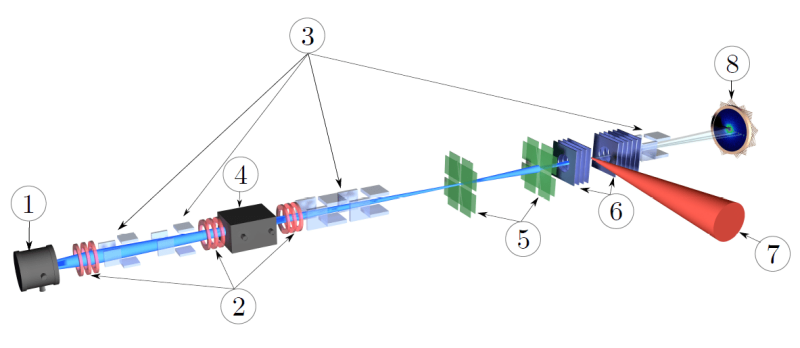Field emission ion sources for laser experiments
Contributing scientists:
F. Machalett1,2, P. Wustelt1,2, B. Ying1,2, V. Huth2, T. Weber2, Th. Stöhlker1,2 and G.G. Paulus1,2
1 Helmholtz Institute JenaExternal link
2 Institute of Optics and Quantum Electronics, Friedrich Schiller University Jena
The aim of these investigations is to generate ionic laser targets of high density for the investigation of the ultra-fast laser-induced fragmentation and ionization dynamics of atoms and molecules in strong laser fields. Ionic targets allow the investigation of many interesting fundamental systems of light-matter interaction, such as He+ and H2+ [1] as well as molecules that only arise in the ion source, e. g. HeH+ [2]. A further advantage of ionic targets is the possibility to clearly define and control the interaction volume for the laser beam. Figure 1 shows the schematic structure of the ion beam system and the position of the ion-laser interaction.
Fig. 1: Schematic view of the setup for the strong field laser experiments: 1: liquid metal ion source, 2: Einzel lens, 3: parallel plate deflector, 4: Wien filter, 5: slit diaphragm, 6: spectrometer, 7: laser, 8: detector
Graphic: Vanessa HuthIonic laser targets, which are generated, for example, by ion sources such as Duoplasmatron, EBIT and RF, have the drawback of low densities in the range of 104-105 cm-3 in the laser focus. The resulting small number of molecules in the laser focus requires relatively long measurement times.
To overcome these problems, an alternative ion source with a higher brightness (directional beam value) is desirable. The aim is to generate higher particle densities that are closer to those of neutral targets, which have typical values of about 1011 cm-3 for cold supersonic gas jets.
A promising candidate is a Liquid Metal Ion Source (LMIS, Figure 2), based on field evaporation from a liquid metal cone with a tip radius of 10 to 30 nm. Because of its special properties this type of source is mainly used as a Field Emission Electric Propulsion (FEEP) system in space or as ion source in Focused Ion Beam (FIB) Systems for nano-structuring.
Fig. 2: Liquid metal ion source housing (left) with ion getter pump (1) and extraction electrode (2) and (right) without extraction electrode with visible ion emitter (3) [5]
Image: Vanessa HuthThe LMIS has the following advantages [3,4]:
- Small source size results in high brightness of 106 A cm-2 sr -1
- Simple and compact setup (see Fig. 2)
- Ions from a variety of chemical elements possible (almost half the periodic table) by the use of liquid alloys
- Numerous combinations of different stoichiometries in the molecular ions of an element or between different elements
- Investigation of noble metal molecular ions (e. g. Au2+, Au3+, Au32+) and noble metal compounds
(e. g. AuSi+, AuGe+)
References:
[1] T. Rathje, et al., External linkPhys. Rev. Lett. 111, 093002 (2013)
[2] P. Wustelt, et al., External linkPhys. Rev. Lett. 121, 073203 (2018)
[4] L. Bischoff, et al.External link, Appl. Phys. Rev. 3, 021101 (2016)
[5] V. Huth, Construction and characterization of a liquid metal ion source for strong field laser experiments, Bachelor's Thesis, FSU Jena, 2020-10-17

![Fig. 2: Liquid metal ion source housing (left) with ion getter pump (1) and extraction electrode (2) and (right) without extraction electrode with visible ion emitter (3) [5]](https://www.physik.uni-jena.de/pafmedia/142730/fluessigmetallionenquelle.png?height=322&width=800)